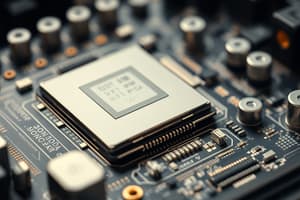Podcast
Questions and Answers
What is the purpose of a Tri-wing screwdriver?
What is the purpose of a Tri-wing screwdriver?
- To bend wires and cables
- To secure components in place
- To cut wires and cables
- To unscrew screws on Apple products (correct)
Which type of pliers is best suited for reaching and gripping hard-to-access components like connectors and cables?
Which type of pliers is best suited for reaching and gripping hard-to-access components like connectors and cables?
- Flat-nosed pliers
- Wire-cutting pliers
- Needle-nosed pliers
- Long-nosed pliers (correct)
Why is it important to use the appropriate screwdriver for the screw type?
Why is it important to use the appropriate screwdriver for the screw type?
- To increase the lifespan of the screwdriver
- To make the task easier
- To avoid electrical shock
- To prevent damage to the screws (correct)
Which action should be avoided when using screwdrivers to prevent damaging components?
Which action should be avoided when using screwdrivers to prevent damaging components?
What feature should pliers have when used for ICT work to prevent electrical shock?
What feature should pliers have when used for ICT work to prevent electrical shock?
What is the primary function of a screwdriver in computer hardware servicing?
What is the primary function of a screwdriver in computer hardware servicing?
Which type of screwdriver is commonly used for Phillips screws in computer hardware?
Which type of screwdriver is commonly used for Phillips screws in computer hardware?
What is the specialized use of a Pentalobe screwdriver in ICT work?
What is the specialized use of a Pentalobe screwdriver in ICT work?
Apart from smartphones, where else are precision screwdrivers essential in ICT work?
Apart from smartphones, where else are precision screwdrivers essential in ICT work?
Which hand tool plays a vital role in gripping, bending, and cutting wires during computer hardware servicing?
Which hand tool plays a vital role in gripping, bending, and cutting wires during computer hardware servicing?
Study Notes
Essential Hand Tools for Computer Hardware Servicing
When it comes to servicing computer hardware and maintaining Information and Communications Technology (ICT) equipment, having the right tools is as crucial as knowing how to use them. In this article, we'll delve into two fundamental hand tools that play a vital role in the process: screwdrivers and pliers.
Screwdrivers
Screwdrivers are the unsung heroes when it comes to ICT hand tools. They are used to loosen or tighten screws to access or repair various components within a computer, such as:
- Desktop computers: Motherboards, power supplies, and cases all have screws that require specialized screwdrivers.
- Laptops: Screws secure the display, keyboard, and other internal components.
- Smartphones: Dismantling a phone requires the use of precision screwdrivers.
There are several types of screwdrivers that are particularly helpful for ICT work:
- Philips (cross-head) screwdriver: Essential for most computer hardware as it is used for Phillips screws.
- Flat-blade screwdriver: A must for screws with flat-headed or slotted designs.
- Torx screwdriver: These are used for Torx screws, which are commonly found in high-end consumer electronics and laptops.
- Pentalobe screwdriver: Originally developed by Apple, this type of screwdriver is used to secure the back cover of iPhones and iPads.
- Tri-wing screwdriver: This is another proprietary screwdriver found on various Apple products, such as MacBook laptops.
Screwdriver sets are convenient, as they often include the most common sizes and types of screwdrivers. However, it is essential to be discerning when purchasing such sets to ensure they include the precise screwdrivers needed for your specific needs.
Pliers
Pliers are useful for a wide array of computer hardware jobs, and they come in various styles to address specific needs:
- Long-nosed pliers: These are helpful for reaching and gripping components that are difficult to access, such as connectors and cables.
- Needle-nosed pliers: These are useful for similar tasks as long-nosed pliers but are more slender and precise, making them ideal for delicate work.
- Locking pliers (Vise-grips): These are helpful for securing components and holding them in place while performing other tasks.
- Flat-nosed pliers: These are used to bend or shape wires and cables.
- Wire-cutting pliers: These are used to cut wires and cables of various thicknesses.
When purchasing pliers for ICT work, it is essential to opt for high-quality tools with corrosion-resistant finishes and insulated grips to prevent electrical shock.
Tips for Using Screwdrivers and Pliers
- Use the appropriate screwdriver for the screw type: Using the wrong screwdriver can damage screws and make it difficult to loosen or tighten them.
- Apply even pressure when turning screwdrivers: Avoid jabbing or jerking when using screwdrivers to avoid damaging components.
- Keep pliers clean and free of debris: Pliers that are not clean can scratch or damage components and circuits.
- Use pliers carefully: Applying too much force or using the wrong plier type can cause damage to components.
In conclusion, screwdrivers and pliers are foundational tools for servicing computer hardware and ICT equipment. Once you have the right tools, you can confidently take on a range of tasks from basic troubleshooting to more advanced repairs. With the right knowledge and tools, you can keep your devices in optimal working condition and extend their lifespan.
Studying That Suits You
Use AI to generate personalized quizzes and flashcards to suit your learning preferences.
Description
Explore the fundamental hand tools crucial for servicing computer hardware and maintaining ICT equipment, focusing on screwdrivers and pliers. Learn about the types of screwdrivers useful for desktops, laptops, smartphones, and more, as well as the various styles of pliers for different hardware jobs. Discover tips for using screwdrivers and pliers effectively to handle basic troubleshooting and advanced repairs in ICT work.




